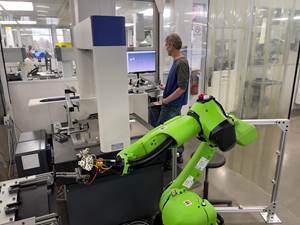Plain Talk about Data-Driven Manufacturing
The value is in better decisions. Machine monitoring is the first big step.
Data-driven manufacturing simply means that we can make better decisions about manufacturing processes because computer networks make it possible to gather lots of data from connected devices and turn that data into actionable information. Right now, one of the best examples of data-driven manufacturing is machine monitoring—connecting machine tools and other types of manufacturing equipment to a network so monitoring software can show what’s happening on these machines. Shop owners and managers can then find out which machines are running or not running, and take steps to keep them running or start them running again. If a machine is not running, the reason why will be clear. It’s in setup. A tool is broken. It’s down for scheduled maintenance. Somebody didn’t remove an optional stop from the CNC program that’s no longer needed.
Taking immediate actions such as rushing a replacement tool to the stopped machine is one possibility. Starting a setup-reduction program is another action that will result in a long-term fix to the problem of excessive setup time.
Machine monitoring is a good example of data-driven manufacturing because all of the key ingredients for data-driven manufacturing come into play. The first ingredient is having a network to connect to. Most shop networks use the internet, because the technology for an internet-enabled network is relatively easy and inexpensive to set up. Once a network is set up, machine data can be shown on big-screen TVs on the shop floor, for example. The data can be accessed on desktop computers in engineering and management offices. Mobile devices such as smartphones and tablets can access the data remotely, too.
Using the internet makes it possible for all kinds of connectable devices and control systems to be linked together to share and respond to data. This is one reason why the term Industrial Internet of Things is popular right now. Using the internet also opens the door to cloud-based applications and remote data storage.
Of course, data-driven manufacturing depends on being able to collect the data shops need for decision-making. Here again, machine-monitoring systems have taken the lead in promoting the interoperability and exchangeability of machine-generated data. For example, machine monitoring was one of the first applications to take advantage of MTConnect, the open-source interoperability standard that translates machine data into a common, internet-based language. Since it made its first big appearance at IMTS in 2008, MTConnect has been widely adopted by machine tool builders and suppliers of many types of manufacturing equipment. MTConnect adapters even enable older machines and simple control systems to deliver usable data to the network.
All kinds of smart sensors are now being developed to report on the status or condition of machine components, subsystems and accessories. These sensors need a common language such as MTConnect. Otherwise, proprietary formats or closed systems will be a barrier to sharing data on a shop-wide, networkable basis.
I think it’s safe to say that data-driven manufacturing is revolutionary. This revolution is already happening because operators, supervisors, managers and shop owners must and can have reliable, up-to-date facts and figures to make decisions. We can get away from using guesses, assumptions, opinions or stale, incomplete data to determine what steps or actions to take next. We can measure and control. The real impact of this revolution can be seen in the shops that have put machine-monitoring systems in place. Just having uptime readings or OEE ratings displayed on a big screen encourages shop personnel to do the simple things that boost uptime by 10 to 20 percent off the bat.
And once the machine-monitoring infrastructure and shop culture are in place, manufacturing companies can easily move to other opportunities for connecting machines and processes so data can be shared and responded to automatically. For example, self-correcting feedback loops linking machine tools, measuring equipment and programming software become doable and practical. Likewise, “machine health” will be easier to detect, making it possible to predict and prevent downtime due to component failures or maintenance issues. CAM software, cutting tool libraries, tool cribs, tool presetters and machine controls will become unified systems.
Data-driven manufacturing represents a sweeping advance for manufacturers. It’s no wonder it’s being called the fourth Industrial Revolution or Industry 4.0. I’m convinced that machine monitoring is the gateway to this new world. Machine monitoring is the catalyst that is setting off a chain reaction that makes manufacturing more productive, more profitable and more personally rewarding for everyone involved.
Related Content
Machine Monitoring Boosts Aerospace Manufacturer's Utilization
Once it had a bird’s eye view of various data points across its shops, this aerospace manufacturer raised its utilization by 27% in nine months.
Read MoreBeyond the Machines: How Quality Control Software Is Automating Measurement & Inspection
A high-precision shop producing medical and aerospace parts was about to lose its quality management system. When it found a replacement, it also found a partner that helped the shop bring a new level of automation to its inspection process.
Read MoreWireless Couplers Work Wonders for Workholding
Possibilities range from individual control of chuck jaws and tombstone fixtures to more reliable robots.
Read MoreShop Moves to Aerospace Machining With Help From ERP
Coastal Machine is an oil and gas shop that pivoted to aerospace manufacturing with the help of an ERP system that made the certification process simple.
Read MoreRead Next
The Cut Scene: The Finer Details of Large-Format Machining
Small details and features can have an outsized impact on large parts, such as Barbco’s collapsible utility drill head.
Read More3 Mistakes That Cause CNC Programs to Fail
Despite enhancements to manufacturing technology, there are still issues today that can cause programs to fail. These failures can cause lost time, scrapped parts, damaged machines and even injured operators.
Read More









.png;maxWidth=300;quality=90)



.png;maxWidth=300;quality=90)









